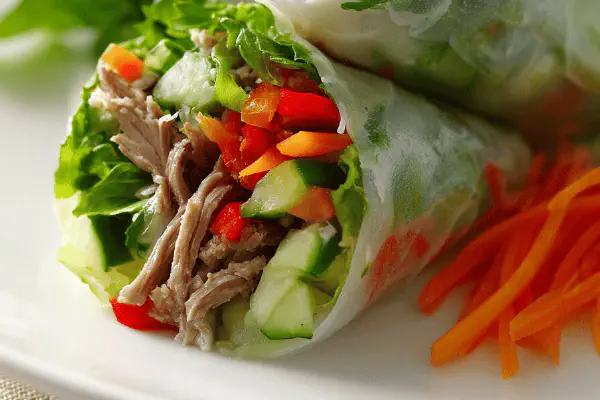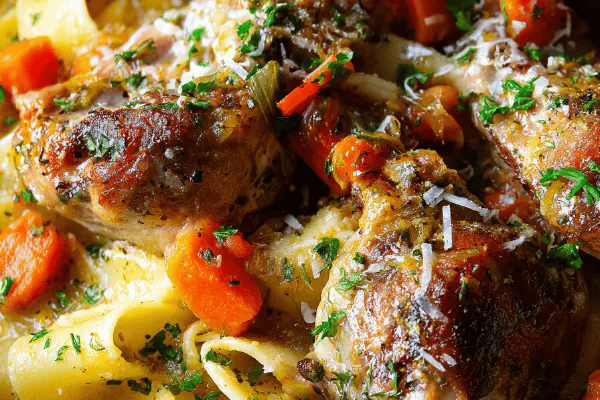Duck Confit Spring Rolls

By Emma
Certified Culinary Professional
Ingredients
Sauce
- 100 ml (1/3 cup) hoisin sauce
- 80 ml (1/3 cup) water
- 15 ml (1 tbsp) freshly grated ginger
- 15 ml (1 tbsp) lime juice
- 5 ml (1 tsp) rice vinegar
Rolls
- 70 g (2 1/2 oz) rice vermicelli
- 12 to 14 rice paper wrappers, 22 cm (8.5 in)
- 2 Lebanese cucumbers, julienned fine
- 375 ml (1 1/2 cup) shredded duck confit or shredded roasted chicken
- 2 scallions, thinly sliced
- 1 red bell pepper, cut into thin strips
- 1/2 bulb fennel, thinly sliced lengthwise
- 1 cup baby watercress or baby spinach
- 24 fresh basil leaves
- 30 g (1 oz) quick pickled carrots (optional, for tang and crunch)
About the ingredients
Method
Sauce
- Combine hoisin, water, ginger, lime juice, and rice vinegar in a bowl. Stir until uniform. Refrigerate for flavors to meld. Adjust balance if too sweet or thick; add more lime for brightness or water to thin.
Rolls
- Soak vermicelli in boiling water until soft but with slight bite (about 6 to 7 minutes). Rinse under cold water to halt cooking, drain thoroughly. Clumps? Flick fork through. Never skip draining or rolls become soggy or sticky inside.
- Fill large bowl with very hot water for softening wrappers. Submerge one wrapper at a time just 12 to 18 seconds. Watch the edges soften but not tear. Too long? Tears; too short? Breaks while rolling. Drain on clean tea towel or paper towel to remove excess moisture; soggy paper is a rookie mistake.
- Lay wrapper flat on clean surface. At one edge, arrange a line of cucumber julienne (about 2 tbsp), then layer 2 tbsp shredded duck and vermicelli beside it. Scatter scallions, bell pepper strips, fennel slivers, handful of watercress, and two basil leaves opposite cucumber side. Sprinkle quick pickled carrots sparingly — adds snap and subtle acidity.
- Fold sides of wrapper inward over filling, reduce gap for firm roll. Roll tightly from cucumber edge so filling held like little parcel. Firm but gentle pressure to avoid tearing. If roll feels flimsy, pat wrapper dryer next time. Cover each roll as you go with damp cloth to prevent drying.
- Serve rolls cold or at room temperature with chilled sauce. Dip or spoon sauce generously, the sharp ginger-lime notes cut through richness of duck. Leftovers in fridge wrapped individually in cling’ll last a day; vermicelli can rubberize– best fresh.
- Pro tip: If duck confit unavailable, swap for leftover shredded chicken or turkey roasted with herbs, same prep. Watercress substitutes basil’s peppery green note; pale green mint leaves work but reduce total quantity to avoid overpowering.
- This rolling method saves time and makes assembly smooth. Texture contrast key: creamy duck, crisp cucumber and pepper, aromatic herbs. Fennel adds subtle licorice crunch, often overlooked but vital for complexity.
- Heard sizzle? Nope. Still feel that fragrant steam rising off water? Sures the sign vermicelli is done. If vermicelli mushy, reduce soaking next time by couple minutes.
- Avoid overloading rolls or rice paper breaks; better lighter filling, thicker wrapper for neatness. Leftover filling? Turn into salad or toss with vinaigrette for another use.
Cooking tips
Chef's notes
- 💡 Water temp key for soaking rice paper; too hot tears, too cold no softening. Count seconds closely. Test one first before mass prep. Blot dry on towel to stop soggy troubles. Paper varies by brand – adjust soak time same day.
- 💡 Layer veggies first against wrapper edge; cucumber acts foundation. Add duck and vermicelli next, spread thin. Too much filling? Tears or loose rolls. Press gently when rolling — firm but careful not crushing edges or tearing fragile surface.
- 💡 Vermicelli soaking—6 to 7 mins max. Overdo mushy, underdo crunchy. Rinse cold water fast to stop cooking. Flick fork through clumps before draining well. Wet vermicelli = soggy rolls. Dry thoroughly for neat texture and clean mouthfeel.
- 💡 Keep herbs fresh wrapped in damp paper towels till assembly. Basil bruises easily, add last. Mint optional, use sparingly to not overpower delicate balance. Watercress or spinach swaps fine, add peppery brightness versus mild greens.
- 💡 Sauce acid balance crucial; lime juice lifts hoisin heaviness. Add vinegar if brightness needed otherwise omit for sweeter taste. Refrigerate to thicken flavor before serving. Stir before use if thick or separated. Dip generously for contrast.
Common questions
How to tell when rice paper is soaked enough?
Watch edges soften but no holes. 12-18 seconds typical; timing varies by brand and water temp. Too long tears wrapper; too short breaks when rolling. Drain well, blot dry fast or soggy rolls happen.
What if no duck confit on hand?
Use shredded roasted chicken or turkey. Herbs remain key, add enough watercress or spinach for balance. Texture differs but roll method same. Adjust sauce acidity to taste; milder if swapping protein with less richness.
Rolls falling apart or soggy?
Don’t overload filling. Layer cucumber close to edge, wrap sides in tight. Dry vermicelli well. Paper wetness is often culprit. Use damp cloth to keep rolls moist but not soggy. If too soft, pat wrapper drier next round.
How to store leftover rolls?
Wrap individually in cling wrap, fridge up to 24 hours max. Rice paper stiffens over time—best fresh. Sauce refrigerate separately; warm gently before use. No freezer; soggy and chewy after thaw. Use leftover filling in salad, no waste.



